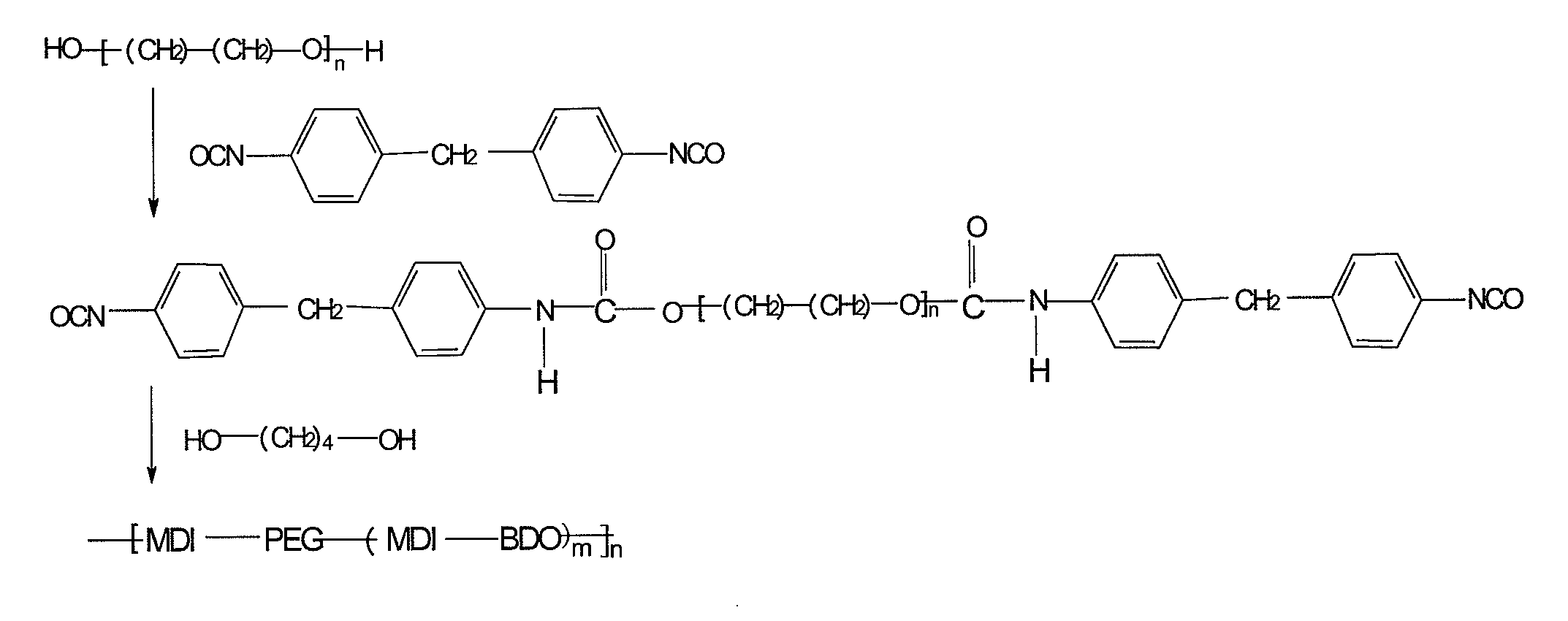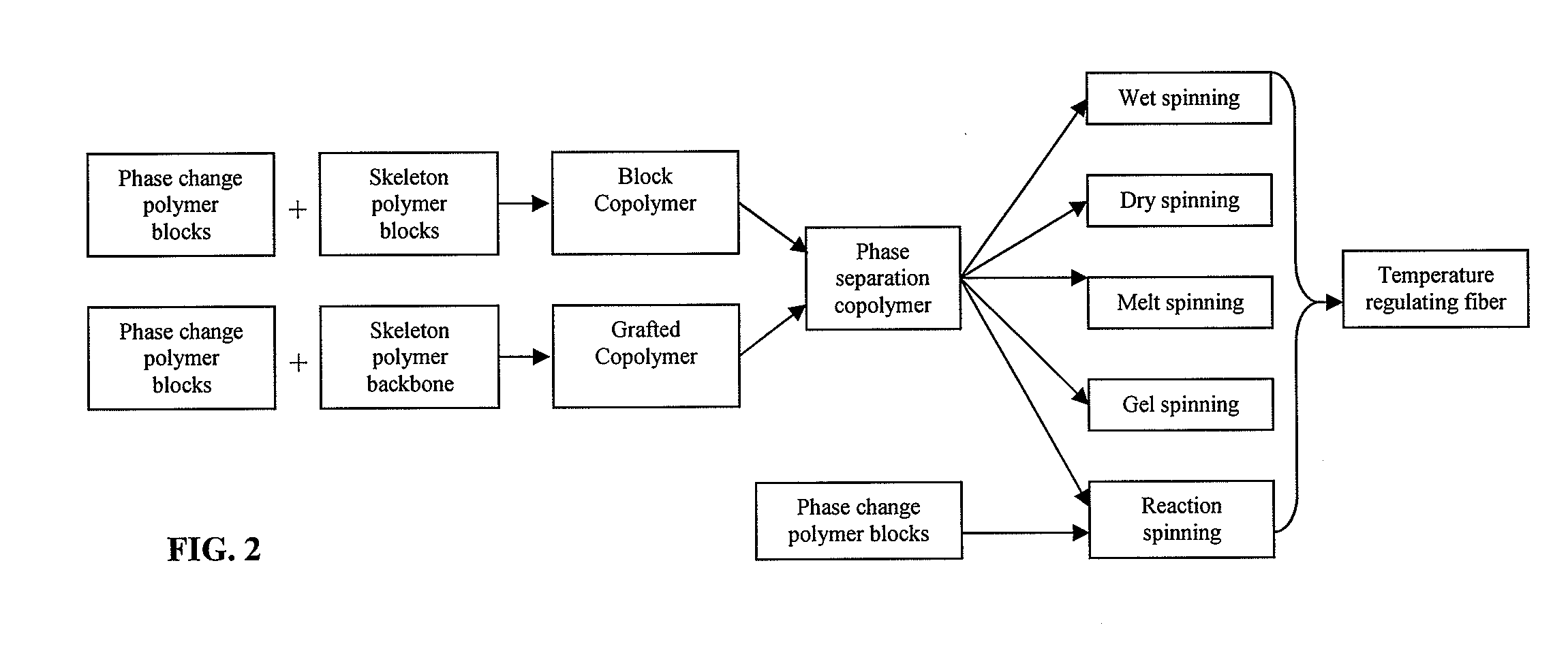Temperature-regulating fiber and a method of making the same
a technology of temperature regulation and fiber, which is applied in the direction of yarn, manufacturing tools, transportation and packaging, etc., can solve the problems of discontinuity in the spinning process, loss of fiber structure and integrity, and low thermal capacity of the prepared fibers
- Summary
- Abstract
- Description
- Claims
- Application Information
AI Technical Summary
Problems solved by technology
Method used
Image
Examples
example 1
Measurement of Thermal Properties and Shape Memory Properties of Fibers
[0047]The phase transition performance was investigated using differential scanning calorimetry with nitrogen as the purge gas. Indium and zinc were used for calibration. The samples were first heated from −50° C. to 225° C. at a 10° C. / min heating rate, and kept at 225° C. for 1 minute to remove the heat history. Subsequently, the sample was cooled to −50° C. at the cooling rate of 10° C. / min. Finally, the sample was reheated at a 10° C. / min rate to 225° C.
[0048]The shape memory properties of the thermo-mechanical cycles were measured according to the steps as shown in FIG. 3. The fiber was first stretched to 100% elongation ratio at Thigh (15° C. above the phase change temperature) at a drawing speed of 10 mm / min. Subsequently, cool air was vented passively into the chamber to cool down the sample to 22° C., and the temperature was kept for 15 minutes to fix the temporary elongation. An upper clamp that was use...
example 2
Method of Making and Properties of a Block Copolymer PEG-3400 Based Temperature-Regulating Fiber
[0049]In this example, the block copolymer was synthesized through bulk polymerization using polyethylene glycol (PEG), PEG-3400, as phase change polymer blocks, and diphenylmethane diisocyanate (MDI) and 4-Butanediol (BDO) as the skeleton polymer blocks. The PEG content in the copolymer was 80 wt %.
[0050]The schematic synthesis route of the block copolymer is shown in FIG. 4. The PEG was first terminated with excessive MDI on both ends at 80° C. for about half an hour. BDO was then added, and the reaction was controlled at below 90° C. for 5 minutes. The molecular structure of the block copolymer is also shown in FIG. 4. The prepared copolymers had a weight average molecular mass of 2.45×105 and a number average molecular mass of 1.65×105. The temperature-regulating fiber was spun by a dry spinning method. The fiber of 100 decitex (dtex) was prepared. The fiber properties are tabulated i...
example 3
Method of Making and Properties of a Block Copolymer PEG-6000 Based Temperature-Regulating Fiber
[0051]In this example, the block copolymer was synthesized using PEG-6000 as the phase change polymer blocks and polyethylene-terephthalate (PET) as the skeleton polymer blocks. The PEG content in the copolymer was 60 wt %.
[0052]The schematic synthesis route of the block copolymer is shown in FIG. 5. The PET segment was synthesized by a transesterification reaction between ethylene glycol and dimethyl terephthalate in a vacuum of 270° C. The PEG was then added with 0.3% catalyst dibutyltin dilaurate to synthesize the PET-PEG copolymer. The reaction was conducted at 0.03 kPa at 260° C. for 1 hour. The copolymer was then extracted with de-ionized water. Finally, the prepared polymer was dried at 80° C. under 0.1 kPa. The molecular structure of the block copolymer PET-PEG is also shown in FIG. 5. The temperature-regulating fiber was fabricated using a single screw at 285° C. by melt spinning...
PUM
| Property | Measurement | Unit |
|---|---|---|
| Temperature | aaaaa | aaaaa |
| Temperature | aaaaa | aaaaa |
| Fraction | aaaaa | aaaaa |
Abstract
Description
Claims
Application Information
 Login to View More
Login to View More - R&D
- Intellectual Property
- Life Sciences
- Materials
- Tech Scout
- Unparalleled Data Quality
- Higher Quality Content
- 60% Fewer Hallucinations
Browse by: Latest US Patents, China's latest patents, Technical Efficacy Thesaurus, Application Domain, Technology Topic, Popular Technical Reports.
© 2025 PatSnap. All rights reserved.Legal|Privacy policy|Modern Slavery Act Transparency Statement|Sitemap|About US| Contact US: help@patsnap.com



